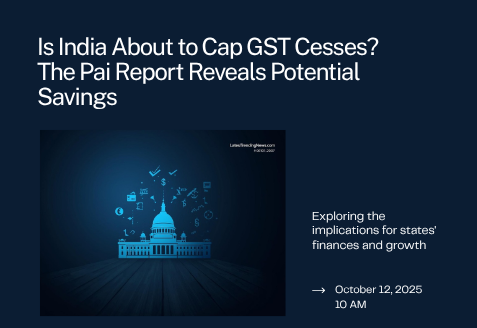
A quiet recommendation has entered the big, noisy debate over India’s public finances. A research group led by TV Mohandas Pai has urged the 16th Finance Commission to consider placing a cap on GST cesses and related surcharges — a change that, if adopted, could meaningfully increase the revenue that flows back to states.
At first glance, the word “cess” sounds bureaucratic and distant. In practice, cesses matter: they are often levied for specific purposes and kept outside the divisible pool of taxes that the Centre shares with states. The Pai group’s case is simple and politically potent — cap how much the Centre can retain as cesses, and more money becomes available for states to spend on hospitals, schools, and roads.
“If surplus cess collections are capped, states could see larger transfers – it’s about balance and fairness between levels of government.” – paraphrase of recommendations from the research group.
A little history: why cesses exist
Cesses were designed as targeted levies — for example, to fund health programs or education initiatives. The idea was noble: earmark money for priority causes. Over time, however, policymakers have layered cesses and surcharges onto the tax system for various needs, and some argue this has blurred the line between temporary levies and permanent fiscal instruments.
Because many cesses are not part of the divisible pool, states can miss out when collections swell. The research group argues that this structural feature can be revisited without undermining core central programs.
What the proposal would change – concretely
- Cap setting: A rule limiting the maximum percentage or absolute amount the Centre can collect as cesses in a fiscal year.
- Redistribution: Excess collections above the cap could be folded into the divisible pool and distributed to states via the Finance Commission formula.
- Program design: The Centre would need to re-examine funding frameworks for programs currently paid from cesses.
Why states would back this and why the Centre may hesitate
For states, the math is straightforward: more shareable revenue means more fiscal space for public investment and services without increasing their own tax burdens. For the Centre, however, cesses are an important tool to fund national priorities and to retain budget flexibility – capping them reduces that immediate flexibility and requires reallocation or new financing approaches.
“The proposal forces a conversation about who should fund what – and how much autonomy states should have to spend.” – policy expert
Potential impacts — short and medium term
Short term: the recommendation will likely spark debate at the 16th Finance Commission and in intergovernmental meetings. States will press for specific estimates of how much additional revenue they could receive.
Medium term: if adopted, the cap could change how central programs are financed – possibly shifting to explicit budget allocations or concessional financing, and prompting a redesign of some centrally sponsored schemes.
Risks & implementation challenges
- Negotiation complexity: The Centre and states will need a formula to determine the cap and the mechanism for redistribution.
- Program finance disruption: Centrally-funded initiatives relying on cess revenues will need alternative funding lines.
- Political consensus: The change requires political buy-in, not just technical fixes.
Past → Present → Possible Future
- Past: Cesses used as targeted levers for health, education, and infrastructure funding.
- Present: Pai-led research group urges 16th Finance Commission to mandate a cap for fairness and redistribution.
- Future: If adopted, states could see a meaningful uplift in their divisible pool — changing fiscal planning across India’s states.
Quick FAQs
Q: Will capping cesses reduce funds for national programs?
A: Not necessarily — it would require the Centre to redesign program financing, potentially moving some initiatives to direct budget lines or shared funding models.
Q: When could this change happen?
A: The 16th Finance Commission reviews such recommendations as part of its multi-year cycle; any change would follow deliberations and political agreement, so expect a medium-term horizon.






